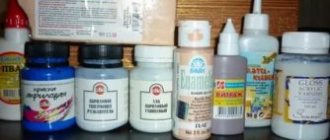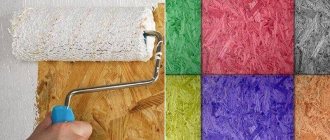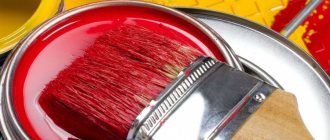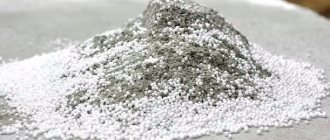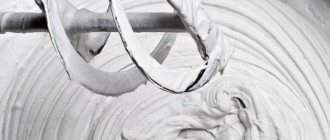Drying oils
Since most oil paints are made from them, drying oils can also be used for dilution. It is also recommended to dilute thickly grated mixtures with them. Drying oil is added to compositions intended for finishing wooden surfaces - a thick layer applied to unpainted wood will crack and crumble over time.
Before you begin breeding, you must study the instructions on the label. To obtain an ideal result, you must use the type of drying oil that was used for its production:
- natural: based on linseed or hemp oil with the addition of metal compounds (driers) that act as accelerators; This thinner for oil paints is odorless, so it can be used even in residential areas;
- oxol: in addition to the above, the use of other types of vegetable oils is allowed in its production; they are partially (up to 40%) replaced with synthetic petroleum-polymer resins;
- combined: prepared by adding up to 30% white spirit to oxol;
- alkyd: based on alkyd resins mixed with modified oils, driers and solvent (white spirit);
- compositional: classified as one of the most budget-friendly compositions; is made on the basis of synthetic substitutes (petroleum products) of vegetable oils; Such drying oil can be distinguished by its reddish tint; has a pungent odor; some of its types are very dry; plus, after hardening, they quickly crumble.
The answer to the question, which thinner for oil paints is better, is natural. But when choosing, pay attention to the color. A dark shade and opacity indicate that this is a fake.
When is thinner required?
If paint is required for application to walls, floors or ceilings in residential or commercial buildings, it will need to be diluted when:
- strong thickening of the material;
- the need to lay a base layer;
- painting wooden surfaces (thick mixtures have poor adhesion to wood).
After use, a small amount of the color mixture may remain, which quickly thickens. In such a situation, breeding is also necessary.
In cases where the dye is needed for artistic purposes: painting walls, creating compositions in the interior, amateur or professional drawing, only special store-bought products are used.
It is easy to spoil the composition with an incorrectly selected diluent, so using traditional methods is not recommended.
Turpentine
This thinner is made from the resin of coniferous trees using distillation. The following types of turpentine are produced by industry:
- gum: the most valuable, distillation is carried out using steam;
- wood, obtained by dry distillation; this method is only possible when using wood containing a high amount of resin;
- extraction: a product of volatile fractions evaporated with the help of organic solvents;
- sulfate: in fact, it is a waste obtained from the production of paper and cardboard, boiled in a solution of caustic and sulfur dioxide; the main reagent is sodium sulfate; Due to high toxicity, use in residential areas is not recommended.
Gum and wood turpentine dissolve perfectly, do not impart excessive dullness to the composition, and have a pleasant pine smell. It is also used as a solvent for oil-phthalic paints. Such compositions are absolutely non-toxic and can be used in residential areas.
Types of solvents for acrylic paints
Acrylic-based paints and varnishes are dissolved with alcohols, ethers and hydrocarbon compounds. Experts divide them into several groups:
- Slow. They are produced at high temperatures, so after adding them the paint will dry more slowly. Such solvents help eliminate the roughness of the created layer and improve the fluidity of the paint to create a glossy surface. Such solvents must be used when working in rooms with low humidity levels and air temperatures above +25 degrees.
- Average. Such solvents should be used when carrying out finishing work indoors and outdoors at temperatures from +15 to +25 degrees with normal humidity levels.
- Fast. R-5, alcohols, solvents with a high evaporation rate. They are used when working at low temperatures. They ensure rapid adhesion of the painted surface to the paint layer and do not allow streaks to form. Paint dries quickly when using fast or volatile liquids, so dust does not have time to settle on the still wet surface of the created coating. In this case, you should work with brushes and rollers, since when using a spray gun, the paint begins to dry even before it comes into contact with the surface.
It is especially important to know which complex solvent for acrylic paints should be used when painting a car. You can create an even and durable coating from acrylic paints and varnishes using solvent R-12. It is used in cases where it is necessary to control the degree of spreading of a substance
If you store acrylic paints correctly, you will not have to use solvents. For such paintwork materials, it will be enough to use ordinary water for dilution. It is the ease of interaction with acrylic-based coatings, which do not require the use of complex solvents with strong odors, that has made them popular in construction.
Our channel in Yandex Zen:
Post Views: View statistics 446
Solvent 647
Oil paints should be diluted with caution. After all, this type of diluent, in addition to alcohols, hydrocarbons and ethers, contains acetone. If you add a little more of it to the paint, the quality of the composition will immediately decrease. The film may turn white or become dull.
As solvent 467 is an aggressive substance, it is best to use it to remove old paint and varnish coatings and film formers. But nitro enamels and nitro varnishes can be diluted with it without fear. Also rinse brushes well with solvent 647.
Additional recommendations
When diluting paints and varnishes, you need to add thinner in small portions so as not to make a mistake with the proportions. This will reduce the consumption of both the product itself and the base material.
An insufficient amount of thinning material increases paint consumption (kg per m2) and makes the coating uneven. Excess leads to smudges and stains; you have to reapply enamel, which also increases its consumption.
To further resist rust and protect the surface being painted, powdered metals can be added to the solution.
The proportion of metal powder added to paint solvent per 1 kg is determined individually, depending on the manufacturer’s recommendations.
When working with solvents, you must remember to take precautions: use gloves and a mask, ventilate the room. If the solvent gets on your skin or eyes, you should promptly wash these areas with warm water and soap and consult a doctor.
Is it possible to dilute paint with gasoline or kerosene?
Quite. Moreover, paints that have become very thick during storage dissolve best in kerosene. Kerosene should be selected well cleaned, otherwise the glossy shine of the paint will disappear. It is better to take A-80 gasoline. When it is added, the properties of the composition do not deteriorate. The jar should indicate that it can be diluted with white spirit.
Due to the specific smell, you should not use gasoline and kerosene indoors. After all, it disappears slowly. Plus, the drying speed will slow down when adding gasoline or kerosene.
Features of diluting oil paints
Paints consist of pigment and drying oil mixed until smooth.
If you do not use the mixture for a long time, the coloring matter will settle, the middle layer will harden, and a lighter oil will float to the surface. Before use, the composition must be thoroughly mixed.
If you need to thin the paint after this, you need to take into account 2 factors:
- specifics of application (for painting or as a primer);
- the type of drying oil used to prepare the dye.
It is important to choose a substance for dilution that is similar to that contained in the coloring material. If the jar with the product has not been standing for long, it is better to dilute it with drying oil.
An incorrectly selected substance will lead to damage to the entire contents of the container, so you will have to carefully study the composition. In case of strong compaction or dilution of the primer, this method will not be effective enough. In such cases, the use of solvents is necessary.
It is necessary to determine how much substance will need to be added. There are no uniform standards due to differences in the composition of dyes and diluents.
The volume of the poured substance should not exceed 5% of the total amount of paint. If white spirit is used to create a primer, the figure increases to 10%. Do not immediately mix the composition in the jar.
It is better to carry out a trial procedure in a glass with a small amount of dye. This will prevent damage to the paint due to incorrect selection of proportions.
During work, the paint mixture may re-thicken due to evaporation of the thinner. The procedure will have to be repeated using a smaller amount of thinning agent.
If the paint has been left in the fresh air for a long time, a number of difficulties may arise. To make it usable, you will need to perform several actions:
- First, the film is removed from the surface. It cannot be mixed into the composition, as this will lead to the formation of lumps. There is no way to get rid of them.
- In a glass, a small amount of dye is mixed with white spirit. Then the resulting mixture is gradually added to the paint can until the desired thickness is achieved.
- If kerosene was used, you can start work immediately or wait until the substance has completely evaporated, and then re-dilute using white spirit.
It is recommended to breed outdoors. This will help avoid headaches, dizziness, watery eyes and nausea that may occur from inhaling paint fumes and thinners.
Dilution of artistic paints
Such compositions are ground pigments dissolved in bleached linseed oil. We'll tell you how to dilute such oil paints. Solvents for them should be selected very carefully. For these purposes you can use:
- refined vegetable oils: hemp, flaxseed or sunflower oil;
- pinene: one of the components of the resin of coniferous trees; goes on sale under the name “Thinner No. 4”, how to use a similar thinner for oil paints can be read on the label;
- multicomponent compositions with the addition of pinene, varnish and oils.
Thus, when choosing thinners for oil compositions, you should focus on the type of surface and the requirements for it. But it should be remembered that excesses of even the highest quality solvent may not have the best effect on the quality of the coating.
How to dilute paint?
To dilute the selected material with water, there is no need to use complex equipment. To work you will need a simple set of devices:
- clean container of suitable size;
- drill with mixer attachment;
- small spatula (if you need to remove lumps).
Breeding scheme:
- The paint is poured into the container. The process is carried out carefully, the composition is mixed a little.
- Water is added gradually. Even taking into account the proportions specified by the manufacturer, it is better to constantly check the viscosity.
- After adding each portion, everything is thoroughly mixed. If lumps are visible, it means that uniformity has not yet been achieved.
It should be borne in mind that the volume is affected by color, so it is added diluted in liquid.
Thinning for different instruments
Ceilings, walls and other surfaces can be painted with different tools, each of which requires a certain level of dye viscosity. At home, the parameter is determined by a viscometer. This is a common device sold in any hardware store. It resembles a funnel with a hole at the bottom of different diameters.
The viscosity level is determined by the time it takes for the composition poured inside the funnel to pass through the nozzle. Measured in seconds. The measurement goes like this:
- The solvent is added to the paint container.
- The contents of the container are mixed.
- A viscometer is immersed in the mixture.
- Prepare a stopwatch or any other device for measuring time in advance.
- The viscometer is removed from the mixture, and at the same moment the stopwatch starts.
- When the mass has completely poured out of the funnel, the timer turns off and the time indicated on it is recorded.
To use a brush or roller, the paint viscosity should be 10-15 s; a dye with a viscosity value of 25-30 s can be applied with a spray gun.
Types of solvents for acrylic paints
Alcohols, esters and hydrocarbons (petroleum distillation products) can be used as solvents for acrylic paints.
Solvents are classified into several types:
- Slow (heavy) - Body 741, Body 742. They are made from substances with a high boiling point, so the drying rate of the coating after their addition is reduced. Slow solvents prevent roughness and provide good flow, which is necessary for a glossy finish. If painting work is carried out at elevated temperatures (above +25°C) and low humidity, then the use of heavy additives for acrylic is mandatory. They are also used when painting a large surface of a car.
- Medium (universal) - P-12, Body 740. Solvents of this type are suitable for external and internal work under normal conditions (+15...+25°C, humidity 50-80%).
- Fast (light) - R-5, alcohols, solvents. Solvents with the highest evaporation rates are used at lower temperatures. They provide quick adhesion to the base layer, prevent the formation of streaks and dust settling on the drying coating. When working with a spray gun, the particles of the mixture with a fast solvent harden before contacting the surface, so the strength of the coating decreases. Light additives are used mainly when painting small parts.
solvents for acrylic paints
The most common in the construction and auto repair industry are complex solvents: R-4, R-5, R-12, etc. They include toluene, acetone, butyl acetate, xylene, ethylcellosol, solvent, cyclohexanone and alcohols.
They are used to control the flow of acrylic enamels, paints and varnishes. For example, P-5 is suitable for painting and most types of coatings, while P-12 is used primarily for painting cars.
In the artistic environment, acrylic thinners are more often used - Tamiya, Khimik, etc.
